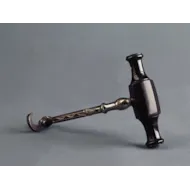A Fine French Ebony Handled and polished cut steel Tooth Key
A Fine French Ebony Handled and polished cut steel Tooth Key marked on the shaft ‘Mariaud’ . One end of the handle unscrewing so that it may be used as an elevator . The central shaft with a feathered and shaped cut steel ratchet altering the position of the key
Circa 1770
Size : 15 cm long – 6 ins long
Circa 1770
Size : 15 cm long – 6 ins long
The Greeks were the first to use extraction as a dental treatment and for many centuries it was the only form of dental treatment available other than crude potions for toothache . Barber – surgeons had little knowledge and poor equipment , only by the mid 19 th century did methods and instruments begin to develop and evolve more rapidly .
Dental treatment was practised by charlatans and quacks well into the 19 th century and was often a sideline of blacksmiths or of mountebanks who drew teeth as entertainment at fairs ; the cries of the poor sufferer being drowned by raucous music from an assistant . Peter the Great ( 1672 -1725 ) fancied himself as a dentist and had a labelled collection of people’s teeth , no. 23 ‘a bishop of Rostov’ that he had extracted himself upon demand . These can still be seen in his Kunstkammer in the museum in St. Petersburg .
Instruments such as this were known as ‘Clef Anglais’ in France , being first mentioned in 1742 . The early keys had a claw with two points , by 1770 a slight bend had occurred in the shaft and later , a double bend to prevent strain on adjacent teeth .
Dental treatment was practised by charlatans and quacks well into the 19 th century and was often a sideline of blacksmiths or of mountebanks who drew teeth as entertainment at fairs ; the cries of the poor sufferer being drowned by raucous music from an assistant . Peter the Great ( 1672 -1725 ) fancied himself as a dentist and had a labelled collection of people’s teeth , no. 23 ‘a bishop of Rostov’ that he had extracted himself upon demand . These can still be seen in his Kunstkammer in the museum in St. Petersburg .
Instruments such as this were known as ‘Clef Anglais’ in France , being first mentioned in 1742 . The early keys had a claw with two points , by 1770 a slight bend had occurred in the shaft and later , a double bend to prevent strain on adjacent teeth .
A Fine French Ebony Handled and polished cut steel Tooth Key

SOLD



